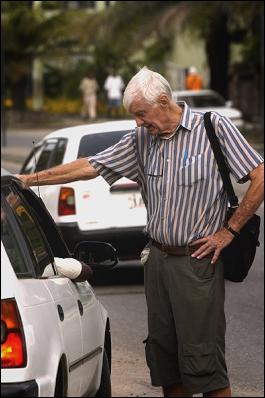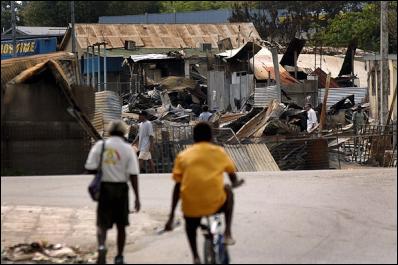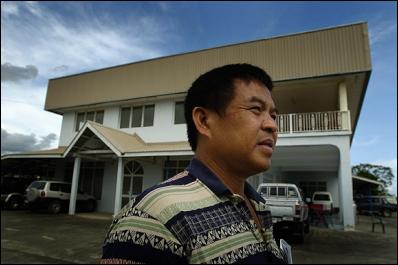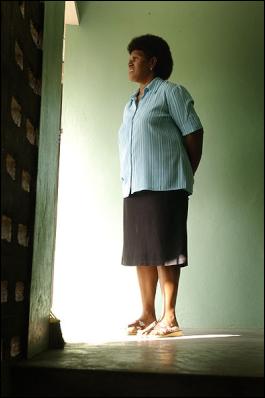The Intelligence Failure Behind Honiara’s Riots
The Intelligence Failure Behind Honiara’s Riots
Images by Jason Dorday
Based on assignment in the Solomon Islands
Rumours are flying across the Solomon Islands as to why the Participatory Police Force failed to prevent much of the extensive rioting that took place in Honiara on 18 and 19 April. Anger flared up following the announcement of Snyder Rini’s appointment to the role of Prime Minister, especially over allegations that Taiwanese money had been involved in buying votes.
The violence did not break out immediately, but rather simmered for a couple of hours before the situation began to rapidly deteriorate. During this time, critics argue that the extensive damage, especially the virtual annihilation of the business quarter known as Chinatown, could have been prevented if correct crowd control had been carried out. Others maintain that the demonstrators outside Parliament were aggravated by the PPF Specialist Operation unit being called in. At 3.23pm, they deployed tear gas and flash grenades on the crowd, which some blame as the real trigger for the riots.

Dr John Roughan believes a Royal Commission into what happened during the riots is needed
Dr John Roughan is originally from New York, but has resided in Honiara for the past 48 years. He has been a vocal critic of its corrupt politicians. He also runs the Solomon Islands Development Trust. The local is amazed that the crowd managed to get all the way to Chinatown from outside Parliament, which is on a hill overlooking Honiara. He is calling for a Royal Commission to investigate what occurred. ‘You had approximately two and a half, if not three hours that this crowd was going down towards Chinatown.’
![]() Audio: John Roughan on the Solomon Islands
Audio: John Roughan on the Solomon Islands
Significantly, access into Chinatown is limited to two bridges over a river. Critics of PPF operations during the riots point out that roadblocks could have been established in the several hours between the beginning of the unrest outside Parliament and their onslaught of Chinatown.

The former business district of Chinatown, targeted by rioters
Naturalised Solomon Islander Patrick Leong says that on Wednesday, around 2.30pm, about 22 PPF were stationed at his Pacific Casino Hotel. The hotel, which is on a seafront property, is not in Chinatown. He says he was told by an officer ‘oh you better go run for your life’. A mob was coming from the Honiara Casino, and he says the PPF left, besides two who stayed with him. He ran out the back exit and escaped on a passing canoe. From there, he watched the destruction of his extensive businesses, including the Pacific Casino Hotel and the Fortune Restaurant. He is critical of RAMSI for failing to protect his businesses. He told Phil Goff last Thursday that he no longer had confidence in RAMSI.
Roughan compares the recent events to a 1989 riot that erupted in Honiara following a soccer game. Then, a crowd of 5,000 youths went rioting. Although the situation could have been very serious, the mob was stopped by police at a bottleneck and the situation was effectively contained. Tear gas was used and ‘the police were very much in charge…There was some looting in Chinatown, but I don’t remember any fires.’
Preplanned and Organised
Evidence and intelligence is now emerging, however, indicating that rather than a spontaneous outburst of anger, the riots were pre-planned and organised by a group of instigators and coordinators that had some kind of hierarchy. This level of coordination made it very difficult for the unprepared PPF to control and disperse the crowds.
Rather than a single mob, there were pockets of rioters popping up across Honiara, and at one stage, on the island of Malaita. This meant resources were spread thinly, and a strategy of life over property was adopted by the PPF, with good reason. Thus you have incredible destruction of local businesses and housing, but no loss of life at all.
Intelligence had only indicated to RAMSI that the demonstration of a few hundred outside Parliament would take place, and consequently, this was where PPF were concentrated. They were not, however, anticipating things to get quite so nasty in even this spot.
In the initial stages, the weapons used by the crowd were spontaneous – mainly rocks. Later on, axes and bush knives were seen, and even some firearms. The perpetrators targeted PPF vehicles, in what appears to be a clear attempt to disrupt PPF mobility. ‘Some of the destruction, with the vehicles particularly, clearly indicated a coordinated, organised approach’, says one anonymous source. The windows would be smashed, and then accelerant poured inside, before the vehicles were set alight.
Walking through Chinatown, two things are very clear. The first is the sheer scale of the destruction. As the photos show, we’re not just talking about a few broken windows and stolen TVs. The buildings are burnt right to the ground. This corresponds with information that small concealed bottles of accelerant were carried by some members of the crowds. Fire services were prevented from getting into Chinatown.
Secondly, certain buildings are still standing, some owned by ethnic Solomon Islanders, but also several belonging to ethnic Chinese. Just what exempted some of these buildings remains unclear.
The extent of simmering tensions with the ethnic Chinese community, while a factor, doesn’t really explain the outburst. As Roughan says, the pre-RAMSI period of serious instability (1998-July 2003), ‘would have been the time, from my point of view, that the Chinese would have felt the pain, the sting. But nothing happened. There was no looting, no burning, nothing.’ The ethnic Chinese community, particularly the newer migrants, have been targets at times, but never on this scale.

Local businessman Patrick Leong outside his house. His properties, including the Pacific Casino Hotel and Fortune Restaurant, were destroyed
The attack on his properties certainly caught Leong by surprise. He says he didn’t call in guards he had available because he didn’t believe his businesses would be targeted: ‘I think I am clean, I am not political’. Leong says he can only guess who was responsible for inciting the destruction of his properties, but that it is likely to be a business competitor.
He thinks the vast majority of the mob were simply looters, while a tiny minority had ulterior motives. This view is held by many others. The waves of looting and burning across Honiara were diverse in nature, some involving deliberate destruction of infrastructure, but others relatively non-violent, opportunistic looting. There are endless reports of families and ordinary Solomon Islanders walking into to buildings and carrying out big screen TVs and the like, in a way that appears to be unconnected to the more sinister motivations behind the riots.
The arrest of Charles Dausabea suggests that he is a key player in the organisation behind the rioting. More details are likely to come out in the trial. But with the corruption which is endemic to Solomon Islands and a political culture that shuns transparency, it may be very difficult to illuminate the full complexities in the public arena. Roughan’s suggestion of a Royal Commission may be the best idea.
Clueless
Given that this level of organisation completely took RAMSI by surprise, it is hard to criticize the way they conducted their operations on the Tuesday and Wednesday of the riots. What should be questioned is why no intelligence was picked up that may have alerted RAMSI of what to expect. Foreknowledge could have prevented much of the damage.
For instance, RAMSI troops were not in Honiara at the time of riots, but in the provinces. The PPF were forced to cope with the outburst alone. This despite the recommendation in the RAMSI Review Report 2004 that RAMSI ‘should provide a standby 100 military personnel in Honiara.’
Sarah Dyer, from the Solomon Island’s National Women’s Council and a candidate in April’s election, says she and others have told RAMSI repeatedly that they need ‘to talk to the people. A member of the Intervention Task Force, a bipartisan body established to monitor RAMSI’s performance and activities, Dyer believes that RAMSI relies too heavily on official sources such as herself, rather than really being in touch with the population.

Sarah Dyer, from the Solomon Islands Council of Women, is critical of RAMSI
![]() Audio: Dyer on Women in Parliament in the Solomons
Audio: Dyer on Women in Parliament in the Solomons
She says her and others have raised the issue repeatedly, particularly during the review process that took place after RAMSI’s first year. Dyer believes RAMSI missed several signs prior to the riots that they may have picked up on had they formed stronger lines of communication with the general populace.
Equally relevant is the fact that throughout the community, there is much dislike of the Australians stationed here. Many feel that they are arrogant, somewhat heavy-handed and don’t understand them. The New Zealanders and other Pacific Islanders working for RAMSI are considered to have a far greater affinity with the population. One taxi driver told me that the New Zealanders ‘are more like us.’
A failure to adequately understand the people is surely not helpful in building relationships and gaining the trust of potential intelligence sources. And it is most likely that it is the Australians who are responsible for intelligence-gathering in the Solomon Islands. Perhaps this responsibility would be better placed in New Zealand’s hands.
As the 2004 review highlighted:
‘RAMSI is a regional undertaking. It should strive, as much as possible, to tap experts and other personnel from all participating countries to have a balance in representation and participation. As it is now, the mission has more Australian experts and personnel.’
Although the report was not referring specifically to the domain of intelligence, the Honiara riots demonstrated that Australian dominance in this area is leading to some grave problems.
No matter how capable the PPF and RAMSI in general are – and the fact that there were no deaths attests to the fact that this is the case – intelligence is the weakest link. This seriously undermines the effectiveness of RAMSI’s entire operations.
The Solomon Islands is a place where human intelligence is vital. Phone lines and electricity are scarce outside Honiara. This is a place where people talk and gossip spreads rapidly. If the Australians are not up to the job, they should collaborate more with their partners in RAMSI.


 Binoy Kampmark: Authoritarian Politics - Netanyahu’s War On Israeli Institutions
Binoy Kampmark: Authoritarian Politics - Netanyahu’s War On Israeli Institutions Keith Rankin: Learning The Correct Lessons From World War Two In Europe
Keith Rankin: Learning The Correct Lessons From World War Two In Europe Ramzy Baroud: Arab Failures - The Unspoken Complicity In Israel's Genocide
Ramzy Baroud: Arab Failures - The Unspoken Complicity In Israel's Genocide Peter Dunne: Dunne's Weekly - The 'War On Woke' Is Really Just A 'War Of Words'
Peter Dunne: Dunne's Weekly - The 'War On Woke' Is Really Just A 'War Of Words' Gordon Campbell: On Israel’s Murderous Relapse, And Peters’ Sad Decline
Gordon Campbell: On Israel’s Murderous Relapse, And Peters’ Sad Decline Howard Davis: An Inconvenient Truth Revisited
Howard Davis: An Inconvenient Truth Revisited